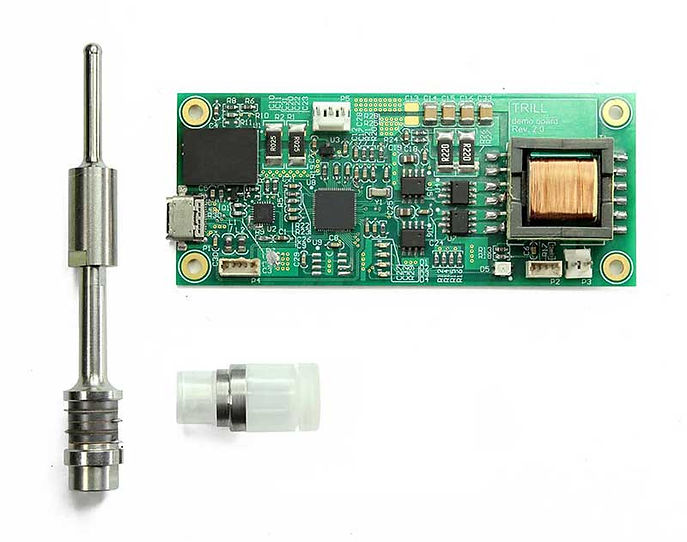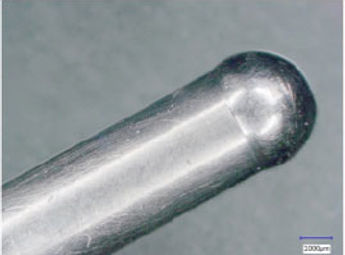
No burn.
No heat.
All acoustics.
A new chapter in
ultrasonic nebulization
technology for viscous media.
Trill is the most innovative, powerful and compact ultrasonic nebulization system for atomization of viscous liquid that is available today.
What is ultrasonic
atomization?
Ultrasonic vaporizers use piezoelectric transducers to produce ultrasound frequencies and vibrations. These vibrations cause liquids to form waves and droplets break from the surface to become mist.
Common ultrasonic devices are found in everyday appliance such as humidifiers and frangrance diffusers. Medical nebulizers use the same principle to atomize inhalation medicine. However, as the viscocity of the liquids increase, the efficacy reduces. Until now, heat and use of HFC propellants are the only methods of atomizing liquids that are more viscous than water.
Forumul8te has pioneered a method using innovative technology to atomize viscous liquids. This cutting edge technique uses a compact and highly efficient, heatless approach for use in the consumer, commercial, and medical fields.
We call this technology Trill.
Current limitations
Conventional ultrasonic nebulizers rely on aerosolization that only works with aqueous solutions. This creates a problem; liquids formulated for aerosolization are rarely water-based, and therefore impractical.
With propellent inhalants or heat-based vaporizers as the only options to atomize such liquids, severe drawback are eminent.
Nebulizers turn aqueous liquid medicine into a mist to help treat various lung illnesses, such as asthma, COPD and cystic fibrosis.
Atomization by
ultrasonic vibrations
Nebulizers
To deliver a drug by ultrasonic nebulizers, the drug must first be dispersed in an aqueous medium. After application of a dispersing force, the drug particles are contained within the aerosol droplets, which are then inhaled. Some drugs readily dissolve in water, whereas others need a co-solvent such as ethanol or propylene glycol. Conventional ultrasonic nebulizers cannot be used to aerosolize suspensions or viscous solutions, because of low efficiency. Liquids that are more viscous than water (1 Centipoise), such as PEG400 (100 Centipoise) require alternative methods of atomization.
Nebulizers
A metered dose inhaler (MDI) is a pressurized inhaler that delivers medication by using a propellant, such as hydrofluoroalkanes (HFA).
Atomization by
propellants
Inhalers
MDIs are small, portable and do not require the use of battery, but coordination is required to time the breathing to the release of the medicine in the lungs. Research has found that approximately 40% of patients first assessed in a specialized respiratory care center or pulmonary function laboratory will not use their MDIs in the best manner. Further, the most crucial components of a MDI is its flammable propellant, making up more than 99% of the delivered dose.
Inhalers
Vaporizers, or more commonly know as vape pens or electronic cigarettes (e-cigs), uses the resistive heating elements to boil liquids into vapor.
Atomization by
heat
Vaporizers
Electronic cigarettes use heat to boil E-liquids into vapor. These liquids primarily contain Propylene Glycol, Glycerin, Nicotine and flavorings. Although glycols and glycerins are generally regarded as safe (GRAS) by the FDA at room temperature, typical E-cigs operate at more than 300ºC. Powerful versions called “mods” often operate at 500-600ºC. Through thermal degradation and fragmentation, harmful chemicals such as Acrolein, Formaldehyde, Toulene, Benzene, Nitrosamines and heavy metals are produced through various mechanistic pathways. Vaporization via heat is never used in the medical field for this very reason.
Vaporizers

Sound
is alive!
Atomization by inaudible
soundwave, delivering the
purest form of aerosol.
In music, the trill is an unmistakable sound: the sustained alternation of notes. This elegant concept inspired the creation of Trill, the personal ultrasonic atomizing system unlike anything else available today.
Features
Cold Atomization
Sub-boiling atomization that maintains liquid integrity
Clean
Prevents the production of harmful chemicals caused by thermal degradation
User Friendly
Easier to use than inhalers
Compact
Portable format with latest battery technology
Intelligent
Advanced algorithm that atomizes both thick and thin liquids
Secure
Authentication feature safeguards against cloning or tampering of cartridges
The Trill
System
Where brilliance
meets simplicity

This breakthrough device integrates commercial-level ultrasonic power into a handheld form factor. For the first time, vaporization and nebulization are possible in a personal device that preserves the potency of viscous liquid as it becomes mist.
01. Transducer
Trill begins with a high performance 50kHz transducer, comprising of multiple stacked piezoelectric elements. It is then, coupled to stainless steel and titanium components— all to produce appropriate displacement at the tip. The configuration of material, size, and electrical specifications generates the maximum possible vibrational amplitude to effectively aerosolize heavy molecules.
Shape

Construction

02. Signal Generator
2
The Trill signal generator is the smallest PLL-capable circuitry available on in the market today, occupying a single-sided board space of only 30cm . Proprietary resonant search and lock algorithm is employed in an encoded custom IC, which monitors the behavior of the transducer in real-time and makes constant adjustments in frequency output to ensure constant resonance and maximum vibrational displacement necessary to atomize viscous liquids.
Shape

Electrical
Characteristics

03. Cartridge
The cartridge works in tandem with the transducer for liquid storage and delivery to the transducer tip. Several layers of customizable wicking material ensure appropriate liquid flow and prevent leakage when not in use. An authentication chip is in integrated into the cartridge, to preventing cloning and tampering. Optional features allow for data monitoring with the ability to log usage frequency and duration, limit use cycles, and adjust output for a variety of liquids and medication.
Shape

Construction


Performance
Data
A series of tests were conducted to benchmark Trill against other atomization methods. Together, factors such as temperature, chemical analysis of the aerosol, quantitative and qualitative measurements of aerosol particles provide the data to proof the superior performance of Trill.
01. Temperature
Side by side
Temperature
Comparison
Trill and a popular e-cig “mod” was placed side-by-side, with atomization points exposed and the temperatures were measured.
Thermal imager maximum detectable temperature is 280ºC. Temperatures beyond detectable range is marked by
The temperature, shown in red, clearly shows the exponential rate increase of heat emitted by the e-cig, exceeding the imager's maximum detectable range of 280°C.
Trill's temperature, shown in green, reaches a maximum of 70°C, a result of the friction created from the vibrating tip moving against the liquid media.

02. Chemical Analysis
The advantages of heatless atomization by ultrasonic vibration is substantiated by a series of chemical tests to characterize and compare impurities in vape aerosols generated between Trill and a standard, heated-mesh (mesh-coil) atomizer. Vape fluid aerosols generated by the mesh atomizer exhibited 14 semivolatile organic species and 9 aldehydes not observed in the original vaping fluid. Vape fluid aerosol created by Trill showed near complete reduction of various harmful chemicals.
Comparison

Brand X 200W Vape Kit outfitted with mesh-coil heater, set to factory recommended 65W. Cycled on for 6 seconds, off for ten seconds.

Trill demo kit V1.1 powered by 7.4V power source, 1.2-2.5A. Cycled on for 10 seconds, off for 10 seconds.
Vaping Fluid
50:50 mixture of glycerin (P&G Chemical, 99.75%) and propylene glycol (Dow Chemical, 99.99%)
Semivolatile
Organic
Compounds
Various studies have shown that aerosols produced from glycol and glycerin can contain chemicals not present in the original fluids. As glycol and glycerin are heated, other chemicals may be released or synthesized during the aerosol generation process, such as Semivolatile Organic Compounds (SVOCs). SVOCs are a subgroup of VOCs, or sometimes polycyclic aromatic hydrocarbons, that have a higher molecular weight and higher boiling point temperature.
SVOCs are of concern because of their potential for negative health effects on humans and are strictly controlled by various air quality control agencies such as EPA and OSHA.
Gas chromatography mass chromatography (GC/MS) is used to analyze the aerosols produced. GC/MS is an instrumental technique by which complex mixtures of chemicals may be separated, identified and quantified.
Results
*Adjusted for relative amount of vape fluid transferred
Aldehydes
Aldehydes are strong electrophiles that can undergo addition reactions with thiols and amines to form toxic adducts in cellular proteins. Aldehydes are also found as industrial or environmental pollutants and volatile aldehydes. Formaldehyde and acetaldehyde have the most significant effects on human health and are found in high concentrations in tobacco smoke and combustion engine exhaust.
Studies have also shown that aldehydes are also produced from thermal degradation of heated glycols. To validate and compare the differences between aerosols produced between heat and ultrasonic atomization, High Performance Liquid Chromatography (HPLC) is used to separate, and identify aldehyde compounds that may be present in the aerosol samples.
Results
HPLC chromatograms of aldehydes recovered from vaped fluids, adjusted for dilution of mesh-coil generated samples

Trace Metals
Heat-based vaporizers rely on the use of resistive heating elements, such as nickel-chromium alloy or stainless steel to convert electricity to heat. The elements in these alloys can vaporize in high heat, creating “metal-fumes” and are often emitted together with the vape aerosol. Other parts of the atomizer, including the container, seals, gaskets and fasteners are also susceptible in leaching metals into the vape fluid.
The elements selected for trace metals analysis were based on those detected within the materials of construction of both devices using scanning electron microscopy with energy dispersive spectroscopy (SEM-EDX). The trace metals were then analyzed using Inductively Coupled Plasma Mass Spectrometry (ICP-MS).
Results

Conclusion
Vaping using commercially available, high-purity propylene glycol and glycerin with a heated mesh atomizer at the recommended wattage generated substantial quantities of thermally generated organic reaction products, some of which are known to be harmful to human health. Trace metals detected appeared to be primarily related to materials of construction of the mesh-coil and the brass heater shell. Lead was also detected, potentially originating from the leaded-brass heater shell.
Vape fluid aerosol created by the Trill ultrasonic atomizer however, resulted in substantially fewer contaminant species with only traces of formaldehyde and acetaldehyde at or near the levels measured within the unused fluid itself. Trace metals found in detected in heated mesh generated aerosol were not present in Trill generated aerosol.
03. Aerosol
03. Chemical Analysis
In vitro testing of partical size by the cascade impactor test method, as required for support in FDA 501(k) premarket notification for aerosol delivery devices.

Aerodynamic
Size
Distribution
Cascade
Impactor
Test
Cascade impactors operate on the principle of inertial impaction. Each stage of the impactor comprises a series of nozzles or jets through which the sample laden air is drawn, directing any airborne towards the surface of the collection plate for that particular stage. Aerodynamic diameter range of 0.5 - 32 microns can be collected and measured.
The aerodynamic diameter of a medicinal aerosol has a direct effect on the ability of the aerosolised drug to deposit in the lungs and is thus an important parameter when developing nebulizers and inhalers. Particles between 0.5 - 5 microns in diameter are determined to deposit more frequently in the lower airways and are appropriate for pharmaceutical aerosols.
Results
Test of Trill with modified
liquid assay using nicotine
solution (viscosity of
250 cP) shows performance
similar to conventional
nebulizers using
aqueous solutions
(<5cP).

Formul8te is founded on on the principles of creating beyond the box technologies for the medical and healthcare industry. We are passionate about innovation and thrive on solving problems to formulate new ideas benefiting patients and society.
Formul8te was established in 2016 by two entrepreneurs with backgrounds in design and engineering with the aim of developing efficient ultrasonic vaporizers for safe and effective delivery of nicotine and inhalation medicine. Our company is headquartered in Singapore, with R&D facilities in Los Angeles and Taiwan.
Our Story
Formul8te’s breakthrough in ultrasonic transduction integrates commercial-level ultrasonic power into a handheld form factor. For the first time, vaporization and nebulization are possible in a personal device that preserves the potency of viscous liquid as it becomes mist. Trill has immediate applicability in diverse markets, transforming industries.

© 2018 Formul8te Pte. Ltd. Patents pending. All rights reserved.

